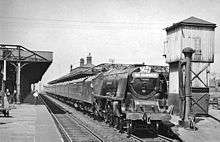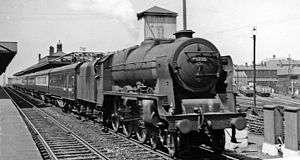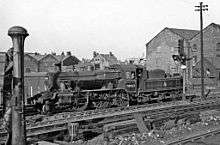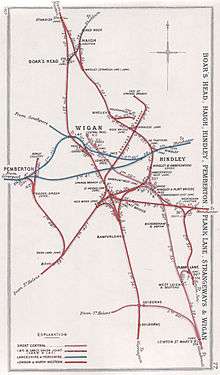Wigan North Western railway station
Wigan North Western railway station is one of two railway stations serving the town centre of Wigan, Greater Manchester, England.
| Wigan North Western | |
|---|---|
.jpg) The station building on platform 4, the main southbound platform, in 2015 | |
| Location | |
| Place | Wigan |
| Local authority | Metropolitan Borough of Wigan |
| Coordinates | 53.5430°N 2.6320°W |
| Grid reference | SD581053 |
| Operations | |
| Station code | WGN |
| Managed by | Avanti West Coast |
| Number of platforms | 6 |
| DfT category | B |
| Live arrivals/departures, station information and onward connections from National Rail Enquiries | |
| Annual rail passenger usage* | |
| 2014/15 | |
| – Interchange | |
| 2015/16 | |
| – Interchange | |
| 2016/17 | |
| – Interchange | |
| 2017/18 | |
| – Interchange | |
| 2018/19 | |
| – Interchange | |
| Passenger Transport Executive | |
| PTE | Greater Manchester |
| Zone | Greater Manchester Rail Zone 3 |
| History | |
| Original company | North Union Railway |
| Pre-grouping | London and North Western Railway |
| Post-grouping | London, Midland and Scottish Railway |
| 31 October 1838 | Opened as Wigan |
| 2 June 1924 | Renamed Wigan North Western |
| National Rail – UK railway stations | |
| |
It is a moderately-sized station on the West Coast Main Line. It is operated by Avanti West Coast, and is also served by Northern Trains.
Wigan's other station is Wigan Wallgate, which is about 110 yards (100 m) away, on the opposite side of the street named Wallgate, for services to Manchester (Victoria, Deansgate, Oxford Road & Piccadilly), Southport and Kirkby. Both stations are centrally located on the southern fringe of Wigan town centre. The station is named North Western, not because of its location but because it formerly belonged to the London and North Western Railway. The drop in usage figures for Wigan North Western in 2006/07 was due to the adjustment of the allocation between the town's two stations. In 2009 North Western station was identified as one of the ten worst category B interchange stations for mystery shopper assessment of fabric and environment[1] and was set to receive a share of £50m funding for improvements.[2]
Description
The station was rebuilt in the early 1970s to a contemporary functional style (see picture, right). The tracks are above street level and access to the six platforms is via a subway and stairs. Recently the goods lifts were modified to allow public use.
- Platform 1 is used for services to both Manchester stations, Stalybridge, Alderley Edge and in the peak, Northern services to Leeds.
- Platforms 2 and 3 are bay platforms, used by a few peak Northern services to Manchester (regular Northern Trains Manchester services serve Wigan Wallgate), and for trains unable to terminate at platform 6.
- Platform 4 is used for Avanti West Coast services to London Euston and Birmingham New Street & Northern Trains services to Manchester Airport and the express service to Liverpool Lime Street.
- Platform 5 is for northbound services to Glasgow Central and Edinburgh Waverley. It is also used for services to Blackpool North and Barrow-in-Furness.
- Platform 6 is used by Merseyrail's City Line services arriving from the Liverpool-Wigan Line. The Liverpool services used platforms 2 and 3 while platform 6 was used infrequently. However, the construction of a new track between Wigan North Western and the junction of the line from Liverpool via St Helens has eliminated the need for these trains to cross the busy West Coast Main Line.
The platforms have heated waiting rooms. The British Transport Police have an office on platform 4 near the station's cafe.
Services
The station is served currently by Avanti West Coast. There is an hourly service on the West Coast Main Line from London Euston, which continues northwards to Glasgow Central, with additional peak services terminating at Preston, Lancaster and Carlisle. The journey time from London is less than two hours (1 hour and 55 minutes).[3] There is also an hourly service in the opposite direction calling at Warrington Bank Quay and London Euston. It is also served by Avanti West Coast's services from London Euston via Birmingham New Street to Glasgow Central and Edinburgh (alternate hours). The single London Midland service from Birmingham New Street to Preston that used to call in the evening was withdrawn at the end of the 2007-8 timetable.
With completion of the first stage of the North West electrification programme, most TransPennine Express services between Manchester and Scotland were re-routed via Wigan instead of Bolton by connecting with the West Coast Main Line near Newton-le-Willows. TransPennine Express now operates services between Manchester Airport and Scotland. These services no longer call at Wigan North Western and have been re-routed via Bolton now that the line is electrified (work finally being completed in early 2019 ahead of the spring timetable update).
Northern Trains operates a half-hourly service from Liverpool Lime Street, along the Liverpool-Wigan Line via St Helens Central with a handful of services running to Liverpool via the Lowton Chord and Newton-le-Willows.[4] There is also an hourly service from Liverpool which continues north along the West Coast Main Line to Blackpool North. Northern also operated one electric hourly service per hour each way between Blackpool North and Manchester Airport between May 2018 & May 2019.[5] Since May 2019, this has been replaced by an hourly diesel service between the Airport and Preston, with most trains continuing on to either Barrow-in-Furness or Windermere.[6] These are mainly operated by new Class 195 Civity units, whilst the electric variants (Class 331s) have started to appear on Liverpool services since the summer of 2019.
Northern Trains services are operated by a mix of Pacer and Sprinter units on the line to Bolton and Manchester. Since the May 2018 timetable change, there are now two trains per hour to/from Bolton - one to Manchester Victoria and Stalybridge, the other to Manchester Piccadilly and thence Alderley Edge via Stockport. These run on weekdays only - weekend trains were replaced by buses until November 2018 due to ongoing electrification work on the Manchester to Preston Line through Bolton and Salford Crescent. From the December 2109 timetable change, most weekday services to/from Manchester via Hindley will revert to their previous route via Wallgate, with just a few trains starting or finishing here in the morning and both peak periods (though a Sunday service via Westhoughton and Bolton to Manchester Victoria will continue).
.jpg)
From the timetable change on 17 May 2015, Northern Rail introduced Class 319 electric services[7] to Liverpool and Manchester, Avanti West Coast services southwards to London Euston and northwards to Glasgow are always operated by electric Class 390 Pendolino trains. Services southwards to London Euston via Birmingham New Street and northwards to Glasgow and Edinburgh are operated by either electric Pendolino trains or diesel Class 221 Super Voyager units.
Future train services
Under HS2 and government proposals' high-speed trains would stop at the station from Glasgow before joining the new HS2 line to Birmingham and London.[8]
Post electrification service proposals include an additional hourly fast to Liverpool Lime Street and two new hourly fast services between Wigan and Manchester via parts of the WCML and Manchester–Liverpool line after electrification of the Manchester to Liverpool line; the rerouting of Scotland services achieves half of this target.
History



Key dates
| 3 September 1832 | The Wigan Branch Railway opened between the Liverpool and Manchester Railway at Parkside Junction (in Newton-le-Willows) and Wigan. The original station in Wigan was located close to Chapel Lane, and three trains per day were provided, connecting with the Liverpool and Manchester trains at Parkside.[9] |
| 31 October 1838 | The North Union Railway opened between Wigan and Preston and connected with the line from Parkside. Wigan station was relocated to its present position. |
| 1846 | The London and North Western Railway was formed as a result of the progressive amalgamation of various earlier lines, including the Grand Junction Railway. In collaboration with the Caledonian Railway, through trains were introduced between London Euston and Glasgow. |
| 2 August 1873 | A major accident occurred at the station. An overnight express from London to Scotland derailed while passing through the station at high speed. 13 people died and 30 were badly injured. The subsequent inquiry into the accident resulted in the introduction of facing point locks to passenger-carrying lines throughout the UK.[10] |
| 1888–1894 | The station was substantially enlarged. The London and North Western Railway's Manchester and Wigan Railway connected with the North Union Railway at Springs Branch, and services to Manchester Exchange via Tyldesley which began in September 1864, terminated at the enlarged station. This line closed in 1969. |
| 2 June 1924 | Renamed from "Wigan" to "Wigan North Western".[11] |
| July 1972 | During 1971 and 1972, the run-down Victorian-era station buildings were demolished and the track layout re-modelled as a prelude to electrification. The re-built station was officially opened in July 1972. |
| 1 October 1972 | All signalling through Wigan North Western and adjacent sections of the West Coast main line came under the control of the new Warrington Power Signal Box. Two large signal boxes were closed - Wigan No.1 and Wigan No.2, which had controlled train movements at the south and north ends of station respectively. |
| 23 July 1973 | Electric train services began between London Euston and Preston, via Wigan North Western Express trains, formerly hauled by one or two Class 50 diesels, were now powered by Class 86 or new Class 87 electrics. |
| 6 May 1974 | The West Coast electrification project was complete and electric trains operated through to Glasgow by British Rail. |
Withdrawn passenger services

Being located on the West Coast Main Line, Wigan North Western has retained regular trains to a wide range of destinations. However, there were several local passenger services from the station which fell under the Beeching Axe and earlier, and the lines have since been closed:
- Blackburn via Chorley (passenger service a pre-Beeching withdrawal in January 1960: see Lancashire Union Railway)
- Trains departed northwards before diverging from the main line at Boar's Head Junction, 2 1⁄4 miles (3.6 km) north of Wigan. From Boar's Head, a line ran to Adlington where it joined the Manchester to Preston Line as far as Chorley. From Chorley another branch line ran to Cherry Tree station and joined the existing line from Preston to Blackburn. In addition to the local service, this route was also occasionally used by long distance trains when these were diverted over the Settle and Carlisle line. Until at least 1963 a "private" non-advertised return passenger service was operated for workers at the Royal Ordnance Factory at Euxton.[note 1]
- Manchester (Exchange) via Tyldesley (local stopping passenger service withdrawn 1962, with some remaining non-stopping local services withdrawn in January 1968: some expresses continuing until May 1969)
- The line from Wigan to Manchester Exchange via Tyldesley and Eccles was the L&NWR's route from Manchester to the north and Scotland. Before closure, this route was used both by local trains and by long-distance expresses between Manchester and destinations such as Windermere and Glasgow. Trains from Wigan North Western to Manchester Exchange travelled south for 1 1⁄2 miles (2.4 km) along the main line before diverging onto the Tyldesley line at Springs Branch Junction. In fact the timings of the non-stop express trains were such that trains between Manchester Exchange and Wigan could (and did) take the (longer) route via Lowton.
- Local trains along main line
- Passenger services were provided to a number of smaller stations located along the main line. Except for Leyland and Balshaw Lane (which was reopened in 1998 as Euxton Balshaw Lane) these stations are now closed. Closure of some of these smaller stations started before the Beeching report (for example Boar's Head and Bamfurlong in 1949 and Golborne in 1962) and was completed in the late 1960s.
- Local trains called at:
Northwards Southwards Boar's Head Bamfurlong Standish Junction Golborne Coppull Lowton Balshaw Lane & Euxton Newton-le-Willows Leyland Earlestown Farington Vulcan Halt Preston Warrington Bank Quay
There are proposals to re-open some of the closed local stations (e.g. Golborne), but none has been approved as of 2018.[12][13]
Wigan Central
Wigan had a third station: Wigan Central which has been demolished.
Wigan Central was located in Station Road, still in the town centre but some way away from the two main stations (at North Western and Wallgate). It was a terminal station on the branch line to Glazebrook and on to Manchester Central.
Wigan Central was opened by the Manchester, Sheffield and Lincolnshire Railway (later to become the Great Central) in October 1892 and was closed to passengers in November 1964.
Notes
- PSUL 1963: 6:33 am SX Wigan North Western—Chorley R.O.F. Halt and return at 4:29 pm SX Chorley R.O.F. Halt—Wigan North Western
References
- Green, Chris; Hall, Sir Peter (1 November 2009). "Better Railway Stations - An Independent Review Presented to Lord Adonis". p. 117. Retrieved 10 June 2020.
- "£50m revamp for 'worst stations'". BBC News. 17 November 2009. Retrieved 17 November 2009.
- Table 65 National Rail timetable,.
- Table 90 National Rail timetable, May 2019
- Table 82 National Rail timetable, May 2018
- Table 82 National Rail timetable, May 2019
- "Electric services to Wigan and Manchester Victoria start in May". Rail. 13 March 2015. Retrieved 31 May 2015.
- "HS 2 – Phase Two". propertyexpertonline.co.uk. Archived from the original on 4 March 2016. Retrieved 31 May 2015. Describes details of the junction south of Wigan, and HS2 stations are identified in the accompanying map.
- Sweeney, Dennis (2008). The Wigan Branch Railway. Triangle Publishing. p. 91. ISBN 978-0-9550030-35.
- "The Wigan Railway Accident". The Bradford Observer. 9 August 1873. p. 8 – via Newspapers.com.

- Butt, R. V. J. (1995). The Directory of Railway Stations: details every public and private passenger station, halt, platform and stopping place, past and present (1st ed.). Sparkford: Patrick Stephens Ltd. p. 250. ISBN 978-1-85260-508-7. OCLC 60251199.
- "Calls for stations to be reinstated". Wigan Today. 25 April 2008. Archived from the original on 27 January 2018.
- "Town is forgotten by HS2 - A town in the borough is fast becoming 'forgotten" by HS2, according to its MP". Wigan Today. 12 December 2017.
- Holt, G.O. (1986). A Regional History of the Railways of Great Britain – vol.10 The North West. David & Charles. ISBN 0-946537-34-8.
- Nock, O.S. (1974). Electric Euston to Glasgow. Ian Allan. ISBN 0-7110-0530-3.
- Sweeney, D.J. (1996). A Lancashire Triangle – Part 1. Triangle Publishing. ISBN 0-9529333-0-6.
External links
| Wikimedia Commons has media related to Wigan North Western railway station. |
- Train times and station information for Wigan North Western railway station from National Rail
| Preceding station | Following station | |||
|---|---|---|---|---|
| St. Helens Central | Northern Trains Liverpool to Wigan Line |
Euxton Balshaw Lane | ||
| Bryn | Terminus | |||
| Preston | Northern Trains Barrow-In-Furness/Windermere - Manchester Airport |
Manchester Oxford Road | ||
| Preston | Avanti West Coast West Coast Main Line |
Warrington Bank Quay | ||
| St Helens Central or Lea Green |
TransPennine Express TransPennine North West |
Preston | ||
| Disused railways | ||||
| Bryn | London and North Western Railway Lancashire Union Railway |
Boar's Head | ||